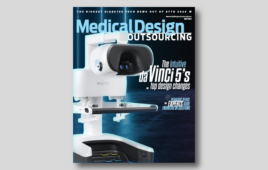Vaporized peracetic acid (VPA) has become a game-changer in medical device sterilization, providing for a room-temperature process designed to preserve newer device materials and components.
Mason Schwartz, Revox Sterilization Solutions

(Image courtesy of Revox Sterilization Solutions)
Advancements in medical device manufacturing have yielded products that are either heat-sensitive or easily degradable. Many materials that would otherwise be ideal for product design cannot withstand traditional sterilization methods such as steam, dry heat, hydrogen peroxide (VHP), ethylene oxide (EtO) or gamma/E-beam irradiation. This limits overall product innovation and, if not considered before product design, interferes with project progression, objectives, and product launch.
Liquid or vapor
Peracetic acid (PAA) is formed by the reaction of acetic acid and hydrogen peroxide (H2O2); these compounds exist in equilibrium and their eventual decomposition results in oxygen (O2), carbon dioxide (CO2) and water (H2O).
The room-temperature VPA process greatly improves material compatibility over other sterilization methods such as hydrogen peroxide (VHP), ethylene oxide (EtO), and gamma/E-beam irradiation. Liquid peracetic acid (PAA) and vaporized peracetic acid (VPA) are highly biocidal sterilants that maintain efficacy in the presence of organic soil while removing surface contaminants.
Through extensive testing of more than 100 materials, VPA has shown high material compatibility. For example, the VPA method can safely sterilize products that would normally be damaged by a liquid chemical, even copper, which is known to oxidize from liquid PAA. A product containing liquid copper was exposed to the VPA process in 10 repeated four-hour cycles, only showing a slight dulling of the original gloss. Tests have also been successfully conducted using multiple sterilization cycles on thermoplastics, thermosets, adhesives, batteries, and bioabsorbables.
Bioabsorbable implants such as internal drug delivery mechanisms, stents, vascular grafts, and scaffolds for tissue engineering rank among the latest cutting-edge medical device categories in the world. They are also among the most heat- and moisture-sensitive products. Sterilizing products like these requires a stable gaseous chemical agent that will not degrade the product. The ethylene oxide (EtO) process typically operates at 40 degrees Celsius, and hydrogen peroxide gas phase sterilizers range between 28 and 60 degrees Celsius, whereas VPA sterilization processes between 18 degrees to 30 degrees Celsius.
Other advantages
VPA’s non-toxic, sterile processing solution leaves behind no harmful residuals, providing not only a safer work environment for employees but a safer product for patients. With VPA breaking down into carbon dioxide, oxygen and water, the VPA process is noncarcinogenic, nonexplosive/flammable, and requires no external ventilation. It can be integrated directly into the on-site manufacturing process, reducing transportation and inventory costs associated with other contract sterilization methods.
Sterilization process time can vary greatly, depending upon the product being sterilized and including the pre-sterilization and post-sterilization aeration periods and external quality processes. Because it requires no pre- or post-aeration, VPA can significantly reduce the overall process time and reduce inventory costs. It also provides the option to bring sterilization on-site, eliminating the inefficiencies associated with off-site sterilization.
Mason Schwartz is R&D and operations director for Revox Sterilization Solutions. He oversaw the invention of the Revox VPA sterilization method for Cantel Medical and has worked with both the FDA and Revox customers to provide support through both PMA and 510(k) submissions.
The opinions expressed in this blog post are the author’s only and do not necessarily reflect those of Medical Design and Outsourcing or its employees.




![A photo of the Medtronic GI Genius ColonPro polyp detection system flagging a potential sign of colon cancer during a colonoscopy. [Photo courtesy of Medtronic]](https://www.medicaldesignandoutsourcing.com/wp-content/uploads/2024/04/Medtronic-GI-Genius-doctors-268x170.jpg)